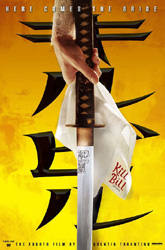 Director: Starring: Release: 20 Aug. 03
|
Thirteen BY: DAVID PERRY Co-written by a 13-year-old, Thirteen tells the story of expedited development, a female maturation that has become common in today’s commercial-minded world. Much news coverage has been made in recent years about young girls going through puberty earlier than ever before because of diets. The statement of this film seems to be that the earlier threshold to sexuality means that daddy’s little girl won’t be his for too long. But as a social commentary film, Thirteen is lacking, showing an amateurishness beyond its high intentions. There is a strong statement within the film, but the direction by first timer Catherine Harwicke does everything it can to show that this is more than just a movie of the week by upping the style until that worry, which is somewhat unmerited, is underlined in her knee-jerk reaction. The story begins with the type of bang that would be needed before the ABC After School Special credits music and first commercial break as two girls, apparently on some drug, begin punching each other with giddy pleasure, calling on the friend-assailant to do it again. While this is a nice introduction to the type of in-your-face dramatization of modern adolescence that Hardwicke relies on, it’s strength as an introduction is felt in the succeeding images of one of those girls, Tracy (Wood), a mere four months earlier. Tracy is an upstanding member of the middle school student population, making good grades, sticking with a clique of honorable friends, and dressing in the epitome of good-girl couture. There is a seedy underbelly -- the recovering alcoholic mother struggling with expenses, the occasional moments of self-mutilation in the bathroom, the absentee father barely interested in his daughter’s problems -- but none of this seems even remotely close to the waif-like sado-masochist who opened the film, pierced and scantily dressed. The trailers for the film have made Tracy’s evolution from honor roll to jailbait explicitly known, which is a shame, because that is one of the hallmarks of Wood’s achievement in this role, never making the transfer seem too movie-world sudden (although the four month timeline is a stretch). If there’s anything this film prides itself in -- and should -- it’s that Thirteen refrains from being merely a cinematic variation on reality. Much of this realism comes from the screenplay by Nikki Reed, who reportedly went through much of what happens in Thirteen. She also plays Evie Zamora in the film, the bad girl whose popularity is what gets Tracy into this quagmire. Her unaffected portrayal of someone she probably sees as a villain in her own life is surprising in its refusal of hyperbole. There isn’t necessarily much positive information given about Evie, but she’s got her background too, stuff that might not give complete reason for her actions but do give some understanding.
What realism Reed, as well as Wood and Holly Hunter (in a
terrific performance as the caring but emotionally lost mother) infuse is
often hurt, though, by Hardwicke’s in-your-face style. Jarring,
guerilla-like filmmaking serves to the detriment of Thirteen, as the
director overcompensates for her own moralizing (ultimately, the film makes
bold statements about advertising and fashion being to blame for the
destruction of our children -- a slowly deteriorating “Beauty is Truth”
sticker follows Tracy during her downfall) by turning to jagged edits, extreme
zooms, shaky cinematography, and washed out film stock. A slicked up
Rossellini is a Rossellini devoid of the attentiveness brought to realist
portrayals. Her best act was telling Reed to write this screenplay; her
worst act was deciding to direct it. |
|
| ©2003, David Perry, Cinema-Scene.com, 10 October 2003 | ||


